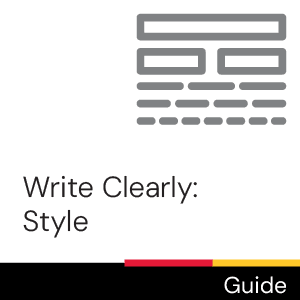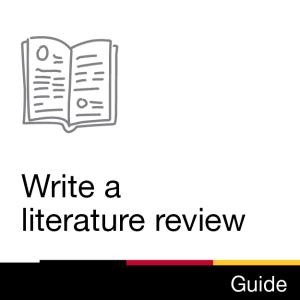Time commitment
2 - 5 minutes
Description
This video offers strategies for adopting a critical voice in your writing.
Video
Transcript
How to Integrate Critical Voice into Your Literature Review
Have you been told to integrate your critical voice into your literature review and you are not sure what that means?
What is critical voice?
Critical voice is when you indicate in your own writing that you are stating your interpretations, ideas, evaluations, and analysis of the literature that you have read.
This video will show you how to develop your critical voice in your literature review.
[A student paper with the title My Literature Review, name, course number, date, and body text. The words “Critical Voice” are overlay the paper in red capital letters.]
First, let’s talk about some questions you can ask yourself while reading and note-taking to help develop your critical voice.
Some of the questions you might ask are...
Do you agree with the authors’ conclusions, and are they significant?
Could anything be influencing the authors’ perspective, conclusions, or arguments, such as funding agencies or stakeholders?
What are the strengths and limitations of the data collection methods?
Does anything important seem to be overlooked or missing?
Are there other ideas related to this topic? Are there other possible interpretations?
While writing your literature review, you can use the following seven tips to help you integrate your critical voice.
Tip #1: Build your argument by using citations to support your position, interpretation, or hypothesis.
Here is a two-sentence example of an argument.
The first sentence shows the argument that the writer is making.
They write, “Canadians should moderate their summertime ice cream consumption.”
In the second sentence, the writer provides supporting evidence.
They write, “Food disappearance data from Statistics Canada, 2018, show that in July through August, twice as much ice cream is consumed when compared to January.”
Tip #2: Indicate how your research project fits within your discipline or research area.
A timeline can help you visualize how your research relates to the past, present, and future developments in your discipline.
When thinking about the past, you can ask yourself, “Where did my research come from?”
When thinking about the present, you can ask yourself, “How does my project relate to the current knowledge and discussions in this research area?”
When thinking about the future, you can ask yourself, “Where could this research be going?”
You can build this timeline by gathering multiple sources to better understand past contributions and to draw conclusions about the current state of your research area.
There are different writing strategies for indicating the past, present, and future of your timeline.
Strategies could include highlighting dates or periods of time, discussing changes over time, indicating ways that the past relates to the present or exploring current controversies and hot topics.
The following is an example of how a writer has used specific words and phrases to establish their research area.
In the first sentence, the writer describes the history.
They write, “Since the 1990s, interventions have demonstrated that lifestyle cancer-prevention strategies are feasible and cost effective (Chua, 2011).”
In the second sentence, the writer shows the relationship of the past to the present.
They write, “This evidence has led to the provincial government’s recent prioritization of cancer prevention programming (Ima, 2018).”
Tip #3: Compare sources to draw conclusions.
[The front pages of six journal articles appear on the screen in two groupings of three.]
This example shows how you can compare sources and draw conclusions.
The first sentence summarizes one group of studies. It reads, “Three key studies found that weight loss interventions that lasted one month in length were effective (Main, 2017; Major, 2009; Raj, 2018).”
The second sentence summarizes a second group of studies, and the comparison with the first group is indicated by the word “however.”
The second sentence reads, “However, studies that lasted six months showed that while participants lost weight initially, their weight rebounded by six months (Lee, 2008; Talmud, 2011; Harrington, 2013).”
The final sentence adds critical voice by providing the author’s conclusion based on these findings.
It reads, “These studies show that while short-term weight loss is possible, long-term weight maintenance is challenging.”
Tip #4: Clearly indicate which ideas and opinions are your own in relation to the literature you’re discussing.
In some disciplines, you would state your opinion using “I” statements in your paper.
This example reads, “I recommend the implementation of gardening programs as a helpful mental health strategy in long-term care facilities.”
Whereas, in other disciplines, any statement without citation information is assumed to be the writer’s interpretation.
This example reads, “Gardening programs would be a helpful mental health strategy in long-term care facilities.”
If you are not sure what the standard is in your discipline, ask your professor.
Tip #5: Show how different articles agree or disagree on findings or interpretations.
[The front page of three journal articles with a green checkmark indicating two of the articles “Agree” and a red “X” indicating one of the articles “Disagree.”]
In this first example, the author specifically uses the word “agree” to indicate agreement.
It reads, “Imran (1975), McGrath (2018) and Chen (2002) agree that time spent outdoors improves mental health.”
The second example reads, “While Green (1975) showed that outdoor activity reduced anxiety and depression, Talmud (1978) found no association between time outdoors and mental wellbeing.”
In this case, the author uses the word “while” to indicate disagreement.
Tip #6: In your writing, identify what has not been studied in the literature. This is commonly referred to as “identifying the gaps.”
[The front pages of four journal articles appear across the bottom of the screen with the words “Identify gaps” above.]
An author can signal a gap using specific words.
For example, this sentence reads, “Despite the importance of these two studies, both have neglected to address the impact of community engagement.”
Here, the use of two phrases “despite the importance” and “have neglected to address” help draw attention to gaps in the literature and contribute to the author’s critical voice.
Tip #7: Indicate the strengths and limitations of studies and address how they affect your interpretation of their results.
You can find strengths and limitations by analyzing a study’s design, methodology, data collection methods, and sample characteristics.
This example shows how identifying strengths and limitations will help you assess the value of different articles.
Study A used a researcher administered survey to examine a sensitive topic. This is a limitation because this survey is more likely to deliver biased results than Study B which used an anonymous survey to examine the same topic.
The author uses the specific words “limitation” and “biased results” to identify a limitation of Study A, which helps shape the reader’s interpretations of this research.
The comparison between Studies A and B is indicated with the word “than.”
This comparison is a form of analysis, which is an important component of critical voice.
[The word “limitation” is highlighted in yellow; the words “biased results” are highlighted in red; the word “than” is highlighted in teal.]
There are many words and phrases to indicate strengths and limitations in order to integrate your critical voice into your own writing.
Words that indicate strengths may include “comprehensive,” “strong,” “exemplary,” “pivotal,” “significant,” contributes,” “compelling,” “thoroughly.”
Words and phrases that indicate limitations may include “suffers,” “may limit,” “only,” “weaknesses,” “small sample size,” “fails to acknowledge,” “inadequately addresses.”
Use these words strategically to decrease wordiness in your writing.
If you’re having trouble integrating enough critical voice, speak to your professor or book a writing appointment in the library.
[A red arrow points to the “Book Appointments” icon on the top of the McLaughlin Library website. On the “What can we help you with?” webpage, an arrow points to the drop-down tab for “Writing, Research Assistance, and English Language Support.”]
Visit lib.uoguelph.ca.
[Questions? Reach out! library@uoguelph.ca]
[Twitter/Instagram: @uglibrary Facebook: /McLaughlinLibrary YouTube: /UoGLibrary]
[This work is licensed under a Creative Commons Attribution-NonCommercial-ShareAlike 4.0 International License.]
License

This work is licensed under a Creative Commons Attribution-NonCommercial-ShareAlike 4.0 International License.
Recommended
- Ask Chat is a collaborative service
- Ask Us Online Chat hours
- Contact Us


.jpg)